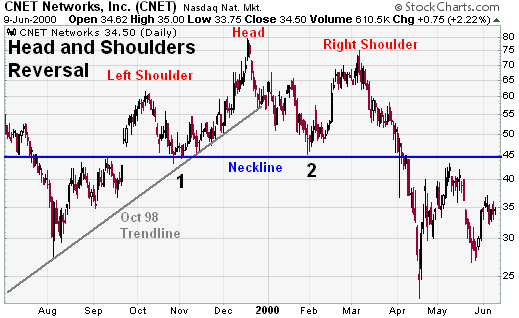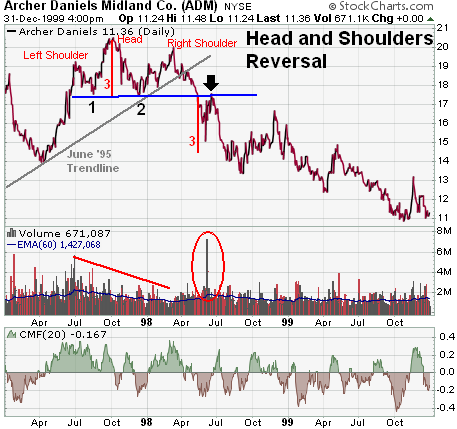Head and Shoulders reversal pattern forms after an uptrend, and its completion marks a trend reversal. The pattern contains three successive peaks, with the middle peak (head) being the highest and the two outside peaks (shoulders) being low and roughly equal. The reaction lows of each peak can be connected to form support, or a neckline.

As its name implies, the Head and Shoulders reversal pattern is made up of a left shoulder, a head, a right shoulder, and a neckline. Other parts playing a role in the pattern are volume, the breakout, price target and support turned resistance. We will look at each part individually, and then put them together with some examples.
- Prior Trend: It is important to establish the existence of a prior uptrend for this to be a reversal pattern. Without a prior uptrend to reverse, there cannot be a Head and Shoulders reversal pattern (or any reversal pattern for that matter).
- Left Shoulder: While in an uptrend, the left shoulder forms a peak that marks the high point of the current trend. After making this peak, a decline ensues to complete the formation of the shoulder (1). The low of the decline usually remains above the trend line, keeping the uptrend intact.
- Head: From the low of the left shoulder, an advance begins that exceeds the previous high and marks the top of the head. After peaking, the low of the subsequent decline marks the second point of the neckline (2). The low of the decline usually breaks the uptrend line, putting the uptrend in jeopardy.
- Right Shoulder: The advance from the low of the head forms the right shoulder. This peak is lower than the head (a lower high) and usually in line with the high of the left shoulder. While symmetry is preferred, sometimes the shoulders can be out of whack. The decline from the peak of the right shoulder should break the neckline.
- Neckline: The neckline forms by connecting low points 1 and 2. Low point 1 marks the end of the left shoulder and the beginning of the head. Low point 2 marks the end of the head and the beginning of the right shoulder. Depending on the relationship between the two low points, the neckline can slope up, slope down or be horizontal. The slope of the neckline will affect the pattern’s degree of bearishness—a downward slope is more bearish than an upward slope. In some cases, multiple low points can be used to form the neckline.
- Volume: As the Head and Shoulders pattern unfolds, volume plays an important role in confirmation. Volume can be measured as an indicator (OBV, Chaikin Money Flow) or simply by analyzing volume levels. Ideally, but not always, volume during the advance of the left shoulder should be higher than during the advance of the head. Together, the decrease in volume and the new high of the head serve as a warning sign. The next warning sign comes when volume increases on the decline from the peak of the head, then decreases during the advance of the right shoulder. Final confirmation comes when volume further increases during the decline of the right shoulder.
- Neckline Break: The Head and Shoulders pattern is not complete and the uptrend is not reversed until neckline support is broken. Ideally, this should also occur in a convincing manner, with an expansion in volume.
- Support Turned Resistance: Once support is broken, it is common for this same support level to turn into resistance. Sometimes, but certainly not always, the price will return to the support break, and offer a second chance to sell.
- Price Target: After breaking neckline support, the projected price decline is found by measuring the distance from the neckline to the top of the head. This distance is then subtracted from the neckline to reach a price target. Any price target should serve as a rough guide, and other factors should be considered as well. These factors might include previous support levels, Fibonacci retracements, or long-term moving averages.
Head and Shoulders Chart Pattern Trend

Archer Daniels Midland Company (ADM) formed a Head and Shoulders reversal with a slightly upward sloping neckline. Key points include:
- The low at 17 1/2 marked the end of the left shoulder and the beginning of the head (1).
- During the advance to 20 1/2, volume was still high, but not as high as during the left shoulder advance. However, during the next advance to 20, volume tapered off significantly.
- Volume continued to decline until the breaking of the neckline. (Note red line on volume bars.)
- The decline from 20 1/2 to 17 1/2 formed the second low point (2).
- During the decline of the right shoulder and neckline break, volume expanded (red oval), and Chaikin Money Flow turned negative.
- After the initial decline, there was a return to the neckline break (black arrow). Even during this decline, Chaikin Money Flow remained negative. The subsequent decline took the stock below 11.
- The measurement from neckline to the top of the head was 3. With the neckline break at 17 1/2, this would imply a move to around 14 1/2. The July ’98 low was 13 1/2. After a decline from 20 1/2, at least, a short reaction rally could have been expected.
The Head and Shoulders pattern is one of the most common reversal formations. It is important to remember that it occurs after an uptrend and usually marks a major trend reversal when complete. While it is preferable that the left and right shoulders be symmetrical, it is not an absolute requirement. They can be different widths as well as different heights. Identification of neckline support and volume confirmation on the break can be the most critical factors. The support break indicates a new willingness to sell at lower prices.
Lower prices combined with an increase in volume indicate an increase in supply. The combination can be lethal, and sometimes, there is no second chance return to the support break. Measuring the expected length of the decline after the breakout can be helpful, but don’t count on it for your ultimate target. As the pattern unfolds over time, other aspects of the technical picture are likely to take precedence.
Source: StockCharts
(Only the headline and picture of this report may have been reworked by the ShareMantras staff; the rest of the content is auto-generated from a syndicated feed.)